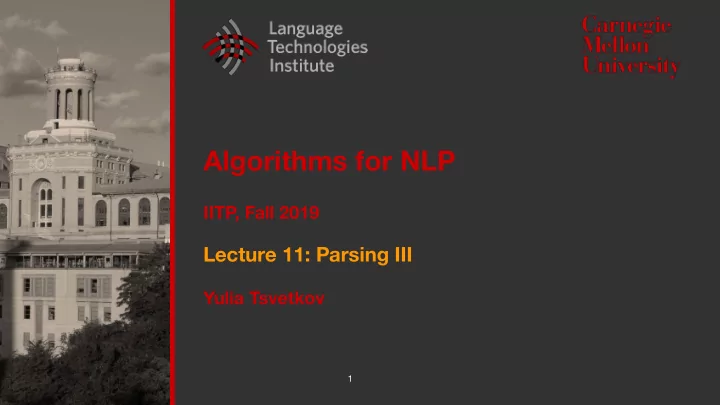

Conversion from constituency to dependency ▪ Xia and Palmer (2001) ▪ mark the head child of each node in a phrase structure, using the appropriate head rules ▪ make the head of each non-head child depend on the head of the head-child
Parsing problem The parsing problem for a dependency parser is to find the optimal dependency tree y given an input sentence x This amounts to assigning a syntactic head i and a label l to every node j corresponding to a word x j in such a way that the resulting graph is a tree rooted at the node 0
Parsing problem ▪ This is equivalent to finding a spanning tree in the complete graph containing all possible arcs
Parsing algorithms ▪ Transition based ▪ greedy choice of local transitions guided by a goodclassifier ▪ deterministic ▪ MaltParser (Nivre et al. 2008) ▪ Graph based ▪ Minimum Spanning Tree for a sentence ▪ McDonald et al.’s (2005) MSTParser ▪ Martins et al.’s (2009) Turbo Parser
Transition Based Parsing ▪ greedy discriminative dependency parser ▪ motivated by a stack-based approach called shift-reduce parsing originally developed for analyzing programming languages (Aho & Ullman, 1972). ▪ Nivre 2003
Configuration
Configuration Buffer : unprocessed words Stack: partially processed words Oracle: a classifier
Operations Buffer : unprocessed words Stack: partially processed words Oracle: a classifier At each step choose: ▪ Shift
Operations Buffer : unprocessed words Stack: partially processed words Oracle: a classifier At each step choose: ▪ Shift ▪ Reduce left
Operations Buffer : unprocessed words Stack: partially processed words Oracle: a classifier At each step choose: ▪ Shift ▪ LeftArc or Reduce left ▪ RightArc or Reduce right
Shift-Reduce Parsing Configuration: ▪ Stack, Buffer, Oracle, Set of dependency relations Operations by a classifier at each step: ▪ Shift ▪ remove w1 from the buffer, add it to the top of the stack as s1 ▪ LeftArc or Reduce left ▪ assert a head-dependent relation between s1 and s2 ▪ remove s2 from the stack ▪ RightArc or Reduce right ▪ assert a head-dependent relation between s2 and s1 ▪ remove s1 from the stack
Shift-Reduce Parsing
Shift-Reduce Parsing
Shift-Reduce Parsing
Shift-Reduce Parsing
Shift-Reduce Parsing
Shift-Reduce Parsing
Shift-Reduce Parsing
Shift-Reduce Parsing
Shift-Reduce Parsing
Shift-Reduce Parsing
Shift-Reduce Parsing
Shift-Reduce Parsing
Shift-Reduce Parsing
Shift-Reduce Parsing Configuration: ▪ Stack, Buffer, Oracle, Set of dependency relations Complexity? Operations by a classifier at each step: ▪ Shift ▪ remove w1 from the buffer, add it to the top of the stack as s1 ▪ LeftArc or Reduce left ▪ assert a head-dependent relation between s1 and s2 Oracle decisions can ▪ remove s2 from the stack correspond to unlabeled ▪ RightArc or Reduce right or labeled arcs ▪ assert a head-dependent relation between s2 and s1 ▪ remove s1 from the stack
Training an Oracle ▪ Oracle is a supervised classifier that learns a function from the configuration to the next operation ▪ How to extract the training set?
Training an Oracle ▪ How to extract the training set? ▪ if LeftArc → LeftArc ▪ if RightArc ▪ if s1 dependents have been processed → RightArc ▪ else → Shift
Training an Oracle ▪ How to extract the training set? ▪ if LeftArc → LeftArc ▪ if RightArc ▪ if s1 dependents have been processed → RightArc ▪ else → Shift
Training an Oracle ▪ Oracle is a supervised classifier that learns a function from the configuration to the next operation ▪ How to extract the training set? ▪ if LeftArc → LeftArc ▪ if RightArc ▪ if s1 dependents have been processed → RightArc ▪ else → Shift ▪ What features to use?
Features ▪ POS, word-forms, lemmas on the stack/buffer ▪ morphological features for some languages ▪ previous relations ▪ conjunction features (e.g. Zhang&Clark’08; Huang&Sagae’10; Zhang&Nivre’11)
Learning ▪ Before 2014: SVMs, ▪ After 2014: Neural Nets
Chen & Manning 2014 Slides by Danqi Chen & Chris Manning
Chen & Manning 2014
Chen & Manning 2014 ▪ Features ▪ s1, s2, s3, b1, b2, b3 ▪ leftmost/rightmost children of s1 and s2 ▪ leftmost/rightmost grandchildren of s1 and s2 ▪ POS tags for the above ▪ arc labels for children/grandchildren
Evaluation of Dependency Parsers ▪ LAS - labeled attachment score ▪ UAS - unlabeled attachment score
Chen & Manning 2014
Follow-up
Stack LSTMs (Dyer et al. 2015)
Arc-Eager ▪ LEFTARC: Assert a head-dependent relation between s1 and b1; pop the stack. ▪ RIGHTARC: Assert a head-dependent relation between s1 and b1; shift b1 to be s1. ▪ SHIFT: Remove b1 and push it to be s1. ▪ REDUCE: Pop the stack.
Arc-Eager
Beam Search
Parsing algorithms ▪ Transition based ▪ greedy choice of local transitions guided by a goodclassifier ▪ deterministic ▪ MaltParser (Nivre et al. 2008), Stack LSTM (Dyer et al. 2015) ▪ Graph based ▪ Minimum Spanning Tree for a sentence ▪ non-projective ▪ globally optimized ▪ McDonald et al.’s (2005) MSTParser ▪ Martins et al.’s (2009) Turbo Parser
Graph-Based Parsing Algorithms edge-factored approaches ▪ Start with a fully-connected directed graph ▪ Find a Minimum Spanning Tree ▪ Chu and Liu (1965) and Edmonds (1967) algorithm
Chu-Liu Edmonds algorithm Select best incoming edge for each node Subtract its score from all incoming edges Stopping condition Contract nodes if there are cycles Recursively compute MST Expand contracted nodes
Chu-Liu Edmonds algorithm ▪ Select best incoming edge for each node
Recommend
More recommend